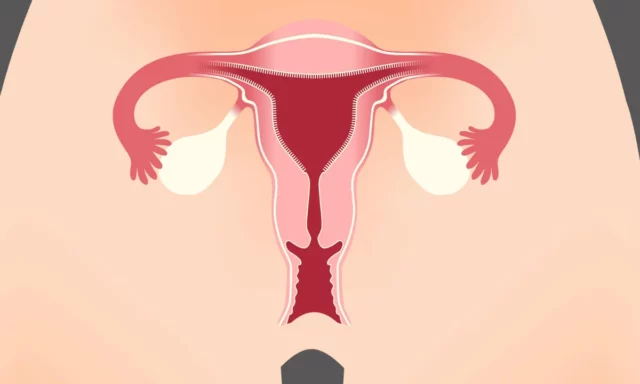Most women experience pain as part of their menstrual cycle. This pain is usually felt as abdominal cramps, which can spread to the back, thighs, legs, and other parts of the body. And it can be experienced in a moderate and constant way during the period, or as stronger and more painful spasms.
Women may also experience nausea, diarrhea, and headaches. The truth is that pain during the period varies enormously between women, from the exact place in the body where it is felt, to the intensity with which it occurs.
Why does the menstrual period hurt?
“Between 30 and 50% of women have painful periods, and some are so strong that they affect their lives”, Dr. Katy Vincent, a pain researcher at Nuffield’s Department of Women’s and Reproductive Health, told the BBC and the University of Oxford, England. “When we have a period, the uterus contracts so that the blood can come out,” she explains. “And that light-headed or dizzy feeling that you feel, which is associated with the expulsion of the clot, is probably the cervix opening a little bit to let that clot pass through and this is accompanied by a contraction”.
It is also known that a lot of inflammation occurs during the period. The tissues of the uterus release chemicals that cause pain, and at the same time, the body produces so-called prostaglandins, which increase during the menstrual period. These are fatty compounds that are produced in cells and have a wide variety of functions in the body.
For example, during menstruation, they cause the uterine muscles to contract and are involved in the inflammatory response, which causes pain. Although prostaglandins are not hormones, they are often associated with them because of the way they work. “We definitely think that prostaglandins are one of the contributing factors to the increased inflammation and pain during your period,” says Dr. Vincent.
But, what is the function of this inflammation and the pain it causes?
“Inflammation has many positive functions. When you are injured, inflammation occurs that carries out a process that helps the tissue to heal and makes you aware that the injury hurts to protect that tissue while it is healing”, says Vincent. It is a necessary process that allows the body to repair itself.
Thus, during menstruation, all the cramping and all the pain is a result of prostaglandins helping the lining of the uterus to heal properly and making sure that all the menstrual fluid is expelled from the uterus. The problem occurs when this process occurs in excessive amounts.

When should you worry about period pain?
For many women who experience pain during their period, it can be relieved with pain relievers or anti-inflammatories. But in some cases, period pain can also be caused by an underlying medical condition. One such disorder is uterine fibroids, also called fibroids, which are noncancerous tumors that can grow in or around the uterus and can make periods heavy and painful.
Menstrual pain can also be caused by pelvic inflammatory disease (PID), a bacterial infection of the uterus, fallopian tubes, or ovaries. PID is often caused by bacteria from sexually transmitted infections, such as chlamydia and gonorrhea. And having unprotected sex with someone who has these infections can cause PID.
Period pain can also occur due to the intrauterine device used for birth control, which is inserted into the uterus to prevent pregnancy. But perhaps one of the most important causes of pelvic pain is endometriosis.
Possible causes of painful menstrual periods
• Endometriosis
• Myomas
• Intrauterine device (IUD), made of copper
• Pelvic inflammatory disease (PID)
• Premenstrual syndrome (PMS)
• Sexually transmitted infection
Source: US National Institutes of Health (NIH).
What is endometriosis?
“We define endometriosis as the presence of tissue from the lining of the uterus -the endometrium– outside the uterus, in abnormal places such as in the pelvic area, ovaries, bladder or intestine”, Andrew Horne explains to the BBC; a Professor of Gynecology and Reproductive Science at the University of Edinburgh, Scotland, who has been researching the causes of endometriosis.
Exactly what causes endometriosis is not yet understood, but it can have a huge impact on the lives of women who suffer from it. “We should not underestimate the impact that endometriosis can have. It really is a terrible disease for the people who suffer from it”, says Horne. “But our understanding of why this disease causes pain is quite limited by now”.
As the expert explains, one of the main problems faced by women with this disease is the difficulty in diagnosing it. “Symptoms of endometriosis are often dismissed because they are thought to be normal (in menstruation)”, he points out. “The other big problem is that endometriosis often has the same symptoms as other disorders, such as irritable bowel syndrome or painful bladder syndrome. So it is not an easy disease to diagnose”.

Symptoms of endometriosis
The ‘classic’ symptom, explains Professor Horne, is pelvic pain during menstruation, but this pain can also arise outside of the period, when defecating, urinating or during sex. Also, endometriosis cannot be diagnosed with a scan or blood test. There is only one way to confirm the presence of the disease: with a laparoscopy.
This is a surgery in which a small abdominal incision is made where the surgeon inserts an observation instrument -laparoscope- in order to detect endometriosis within the pelvic cavity. There is no cure for endometriosis, only treatments can be offered to relieve symptoms.
Endometrial growths can be removed with surgery, or a hysterectomy can be done to remove the entire uterus. And there is also a hormonal treatment. But the goal of endometriosis research is to develop a cure for this disorder, a drug or treatment that can stop the disease and relieve pain for many women.

For those who have experienced shifts in consciousness and know that more peace, joy, and love awaits in a better living environment. A bold shared vision. A living community and hub for innovation. A sustainable ecosystem for living and working. A model for the new future.
